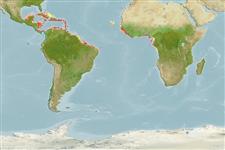>
Ovalentaria/misc (Various families in series Ovalentaria) >
Pomacentridae (Damselfishes) > Glyphisodontinae
Etymology: Abudefduf: Arabic, abu = father; this fish is the leader of the reef against other species (Ref. 45335).
More on authors: Müller & Troschel.
Environment: milieu / climate zone / depth range / distribution range
Ökologie
seewasser riff-verbunden; standorttreu; tiefenbereich 1 - 5 m (Ref. 9710). Subtropical; 24°N - 7°S, 133°W - 62°E (Ref. 56030)
Western Atlantic: southern Florida, USA and the Caribbean Sea. Reported from northern South America (Ref. 5217). Eastern Atlantic: Cape Verde and from Senegal to Angola.
Size / Gewicht / Alter
Maturity: Lm ? range ? - ? cm
Max length : 25.0 cm TL Männchen/unbestimmt; (Ref. 7251); common length : 20.0 cm SL Männchen/unbestimmt; (Ref. 3139)
Rückenflossenstacheln (insgesamt) : 13; Rückenflossenweichstrahlen (insgesamt) : 11 - 12; Afterflossenstacheln: 2; Afterflossenweichstrahlen: 10. Caudal fin lobe rounded (Ref. 7247). A heavy-bodied, compressed species; tawny yellow above, paler below, with 5 or 6 dark bars wider than interspaces between them (Ref. 26938). A sixth faint bar or dark saddle-like mark may be present on upper part of caudal peduncle; a prominent black spot at upper base of pectoral fin (Ref. 13442).
Adults inhabit rocky inshore reefs. They prefer wave-cut rock ledges or limestone shorelines and tide pools in regions with surf. Feed mainly on algae but adults also consume Zoanthus and hydroids while juveniles also feed on copepods (Ref. 9626). Oviparous, distinct pairing during breeding (Ref. 205). Eggs are demersal and adhere to the substrate (Ref. 205). Males guard and aerate the eggs (Ref. 205). Marketed fresh (Ref. 3139).
Life cycle and mating behavior
Maturities | Fortpflanzung | Spawnings | Egg(s) | Fecundities | Larven
Oviparous, distinct pairing during breeding (Ref. 205). Eggs are demersal and adhere to the substrate (Ref. 205). Males guard and aerate the eggs (Ref. 205).
Allen, G.R., 1991. Damselfishes of the world. Mergus Publishers, Melle, Germany. 271 p. (Ref. 7247)
IUCN Rote Liste Status (Ref. 130435)
Bedrohung für Menschen
Harmless
Nutzung durch Menschen
Fischereien: weniger kommerziell
Tools
Zusatzinformationen
Download XML
Internet Quellen
Estimates based on models
Preferred temperature (Ref.
123201): 26.3 - 28.2, mean 27.5 °C (based on 581 cells).
Phylogenetic diversity index (Ref.
82804): PD
50 = 0.5000 [Uniqueness, from 0.5 = low to 2.0 = high].
Bayesian length-weight: a=0.02188 (0.00932 - 0.05134), b=3.08 (2.89 - 3.27), in cm total length, based on LWR estimates for this Genus-body shape (Ref.
93245).
Trophic level (Ref.
69278): 2.1 ±0.1 se; based on diet studies.
Widerstandsfähigkeit (Ref.
120179): mittel, Verdopplung der Population dauert 1,4 - 4,4 Jahre. (Preliminary K or Fecundity.).
Fishing Vulnerability (Ref.
59153): Low vulnerability (15 of 100).
Nutrients (Ref.
124155): Calcium = 49.7 [20.2, 82.2] mg/100g; Iron = 0.637 [0.346, 1.194] mg/100g; Protein = 18.9 [17.5, 20.2] %; Omega3 = 0.116 [0.060, 0.226] g/100g; Selenium = 9.57 [4.07, 22.63] μg/100g; VitaminA = 37.5 [8.0, 169.1] μg/100g; Zinc = 1.12 [0.69, 1.88] mg/100g (wet weight);
